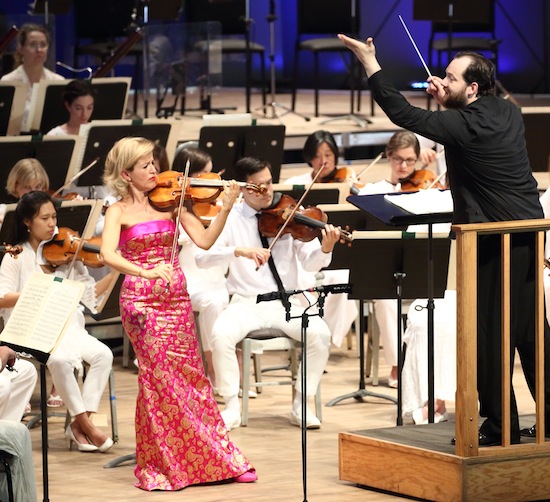Mutter, a Williams premiere and fiery Berlioz at the Tanglewood Festival

Anne-Sophie Mutter performed music of Williams and Tchaikovsky with Andris Nelsons and the BSO Sunday at the Tanglewood Festival. Photo: Hilary Scott
There may be no more familiar figure in the Boston musical firmament than John Williams. The composer served as conductor of the Boston Pops from 1980 to 1993, and he continues in that role even today at Tanglewood, where he leads the annual “John Williams Film Night.”
Williams’ renown for his film scores frequently overshadows his work as a concert composer. A number of his pieces were written for specific soloists. His Oboe Concerto was composed for BSO oboist Keisuke Wakao, and TreeSong was written for Gil Shaham.
Another of the composer’s works made its world premiere in a performance by violinist Anne-Sophie Mutter and the Boston Symphony Orchestra Sunday afternoon at Tanglewood’s Koussevitzky Shed. Markings, written for Mutter, made for a moment of searching solace in a concert characterized by poetry and precision.
Scored for violin, string orchestra, and harp, Markings lasts about seven minutes, but it traverses a satisfying dramatic arc in that brief span. As with his Oboe Concerto, the work is attractive and affecting. The lyrical melodic writing unwinds elegantly over simple, undulating figures in the strings. The solo violin unfolds a series of arpeggios that recall the beginning of Berg’s Violin Concerto. This music breaks into an energetic section that features athletic leaps and running figures for the soloist. A cadenza brings the music back to another slow contemplative section marked by strumming harp figures that supply a golden string of chords.
Mutter played the melodic work with loving attention to details of tone and technique. Her sound radiated with warmth, and Andris Nelsons, who conducted the piece, drew playing of soft grace from the orchestra to match her efforts. With its simplicity and accessibility, Markings would make a fine showpiece for orchestras that wish to feature their concertmaster. One hopes that Mutter will play the work many more times in the future.
A similar sensitivity to the musical line also marked Sunday’s performance of Tchaikovsky’s Violin Concerto.
Here too Mutter and Nelsons make fine musical partners. The duo teamed up for the concerto this past April in Symphony Hall, and their interpretation of the work has deepened since then. Mutter played with freedom of expression when the piece called for it, and she drew out the familiar first movement theme with generous rubato shading. Nelsons mirrored her guide at every turn and led an accompaniment of supple flow and musicality.
The Canzonetta featured a wash of instrumental color. Mutter’s tone was cool and almost spare in her rendering of the theme. Nelsons’ accompaniment wrapped her violin in a soft blanket of sound.
The technical passages of the work were handled with aplomb. After the third movement’s cadenza, Mutter’s phrases took off with driving energy, and her agitated figures of the first movement even drew early applause.
But the applause that followed the concerto was especially long and warm for these musicians. Nelsons, the orchestra, and Mutter teamed up for a haunting encore, the theme from John Williams’ score to Schindler’s List.
After intermission, Nelsons led a bold and colorful performance of Berlioz’s Symphonie fantastique.
As is the case with many Nelsons-led performances, tiny aspects of the score were enhanced due to the conductor’s careful attention to detail. The first movement was a journey from darkness to light, beginning in a broad tempo that unfolded into passages of exuberance. The second movement’s waltz managed to lift off the ground, and in the bucolic third movement, Nelsons took time to spin the English horn and oboe solos in silky curves of melody.
In the March to the Scaffold, the conductor coaxed a long crescendo from the brass theme that appears mid movement, the phrases breaking on the highest note of the line. The Witches’ Round Dance in the finale was a scene of dark, crackling humor as the BSO winds found the impish quality of their featured themes. The brass provided a solid wall of sound when called upon, and the Dies Irae statement seemed to sound from the depths. Death and eternal damnation never sounded so grand.
The next event of the Tanglewood Festival will feature Stefan Asbury, TMC conducting and vocal fellows, and the Tanglewood Music Center Orchestra in music by Brahms, Berg, and Elgar 8 p.m. Monday at Ozawa Hall. bso.org; 888-266-1200
Posted in Performances